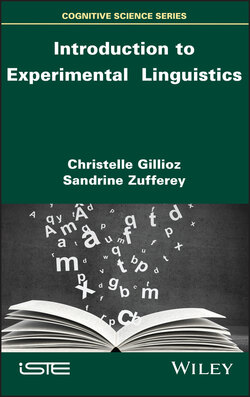Читать книгу Introduction to Experimental Linguistics - Sandrine Zufferey - Страница 8
1.1. The scientific process
ОглавлениеThe experimental methodology in linguistics is part of a scientific approach for studying language. It aims to observe language facts from an objective and quantitative point of view. The general idea behind this approach is that it is impossible to rely on one’s own intuitions in order to understand the world. Quite the contrary, it is necessary to observe objective data reflecting reality. For example, by simply observing the world around us, and relying solely on our own intuition, we might believe that the Earth is flat. This is why the scientific approach, used in fields such as psychology or physics, is based on specific principles and stages, instead of relying on the intuition of scientists. Let us briefly go through these stages:
The first stage in the scientific process involves the observation of concrete phenomena and the subsequent generalization of observations, in order to build a scientific fact: a fact which does not depend on a specific place, time, object or person. At this first stage, it is also possible to trace certain regularities concerning the emergence of a phenomenon, and to try to define the conditions in which such phenomenon generally appears. So, let us illustrate this process by reviewing the stages involved in the discovery of gravitation. This finding is usually attributed to Isaac Newton, who is said to have had a revelation after seeing several apples fall from a tree. As he watched the apples fall, Newton wondered why the apples always fell in a perpendicular direction from the apple tree to the ground, never to the side or upwards.
During the second stage, all of the scientific facts concerning the same phenomenon may prompt the development of a law or theory aimed at explaining such facts. A theory synthesizes knowledge about a phenomenon at a given moment and is therefore provisional, insofar as it can evolve according to new knowledge. We should make it clear that the notion of theory in science is rather distant from the meaning of the word theory as we use it in everyday language. While this word can be used to refer to personal ideas or reasoning mechanisms, its use in the scientific field only applies to coherent and well-established principles or explanations. Going back to our example, in Newton’s time, two models coexisted for describing the movement of bodies: one followed Galileo’s law and was devoted to terrestrial bodies, whereas the other was oriented by Kepler’s law and made reference to celestial bodies. On the basis of this knowledge and his own observations, Newton suggested the existence of a force which made objects attract one another and which could explain the movements of both celestial and terrestrial bodies.
At the third stage, a theory is capable of predicting the emergence of observable facts, or to put it differently, to formulate precise hypotheses which can be put to the test. In order to test these hypotheses, it is necessary to collect a large amount of data and check whether they support the initial theory. In this way, it is possible to know to what extent we can rely on our theory. The more the predictions made on the basis of the theory are fulfilled, that is, the more the data collected corresponds to what might be expected according to the theory, the higher the confidence level will be. Otherwise, if the predictions did not come true, the theory should be put into question and re-examined. Newton’s law of universal gravitation has made it possible to predict and explain the movement of the tides thanks to the moon’s gravitational pull on the Earth, the elliptical movement of celestial bodies or the equatorial bulge.
In summary, the scientific approach is a circular and dynamic process, originating in the reality of the facts, abstracting itself from them in an attempt to explain them, and then approaching them again to check the validity of the explanation.
